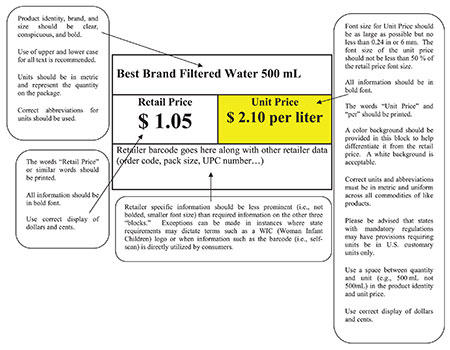
NIST researchers have produced a best practices guide for the design and placement of unit pricing labels. The above schematic shows the kinds of information and the organization of that information as recommended in the guide. See the larger resolution image for more details.
In an effort to help shoppers everywhere get the best value for their money, researchers at the National Institute of Standards and Technology (NIST) have produced a best practices guide for the layout and design of unit price labels. Based on the results of a two-year collaboration among industry and consumer groups, the guide can help retailers and governments improve the accuracy and usability of unit pricing information offered in retail stores, and ensure uniformity of unit pricing across participating retailers and states.
Shoppers have seen them before at the grocery store and many other retail outlets where products are sold by some unit of measure such as weight, volume, length or count. For the most part, unit pricing labels usually display the name and size of the product; the price; the price per unit, e.g., how much you pay per gram or liter or ounce; and other information. Customers can use this information to make value comparisons.
For instance, shoppers wanting to buy a bottle of ketchup might think that buying the larger size will give them the best value , and for the most part that's true. However, stores sometimes levy a surcharge on larger items. Using the unit price labels, a consumer would quite easily be able to see that a 64-ounce bottle of ketchup selling for $4.49 ( 7 ¢ per ounce) was not as good of a deal as a 38-ounce bottle selling for $2.29 ( 6 ¢ per ounce).
Unit pricing also helps consumers make value comparisons in the age of package "downsizing," a practice where the package content is reduced without changing the price of the product.
Unit pricing has been around since the 1970s. Nine states and the District of Columbia require its use. Another 10 states have stipulated that, if a retailer chooses to use unit pricing labels, they have to use guidelines outlined in the Uniform Unit Pricing Regulation (UUPR) in NIST Handbook 130.
According to NIST researcher David Sefcik, the best practices guide was developed using the existing state mandatory unit pricing regulations, the UUPR from NIST Handbook 130, research and surveys done by Consumer Reports (May 2012 issue), the National Consumers League, the Australian Queensland Consumers Association, a Canadian Report on Unit Pricing, researchers at Michigan State University and the University of South Australia, and the knowledge and expertise of the Unit Pricing Best Practices Workgroup.
The guide will help ensure that unit price labels are as easy to read, informative, and as understandable as possible, which, incidentally, is something that consumers want. And giving consumers what they want turns out to be good for business.
"Many retailers don't know the extent that consumers like and use unit pricing when it's available," says Sefcik. "And many don't realize how unit price labels could benefit them (the retailers) as well. Retailers that use unit pricing are perceived as being consumer friendly, improving customer satisfaction and the shopping experience, which keeps customers coming back."
According to the guide, the unit price label has other benefits for retailers, including improved ordering, inventory control, pricing accuracy, and often eliminates the need for item pricing (the little price tag stickers put on the individual items), which saves money.
Unit price labels also can be used to promote special programs such as WIC (Women, Infants and Children), and to display certain kinds of nutritional information such as low-sodium or high-fiber foods.
Their research also revealed that unit pricing promotes and increases sales of store-brand items because they make it easier for consumers to see that they are getting the same amount of a virtually identical product, as compared to another brand, for less money.
"While many grocery stores already use unit pricing labels, there is room for improvement," Sefcik says. He also hopes that the new guide will inspire more retailers, such as auto part stores and drugstores, to adopt them.
Read NIST Special Publication 1181, Unit Pricing Guide, "A Best Practice Approach to Unit Pricing."

